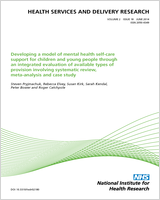NCBI Bookshelf. A service of the National Library of Medicine, National Institutes of Health.
Harris R, Sims S, Leamy M, et al. Intentional rounding in hospital wards to improve regular interaction and engagement between nurses and patients: a realist evaluation. Southampton (UK): NIHR Journals Library; 2019 Oct. (Health Services and Delivery Research, No. 7.35.)

Intentional rounding in hospital wards to improve regular interaction and engagement between nurses and patients: a realist evaluation.
Show detailsIncremental cost analysis of intentional rounding
Introduction
The aim of this analysis was to calculate the incremental cost to the NHS of conducting IR in the wards included in the study instead of not doing it. Three main types of cost were included in the analysis to estimate the total incremental costs:
- direct costs – the cost of any consumable resource directly used for the implementation of IR
- opportunity cost – the value of an alternative service given up to perform IR
- indirect costs – cost of start-up, development and training not directly attributable to IR.
The unit of cost (total costs incurred) was reported in incremental cost per patient per day of hospitalisation. Costs and prices are reported in 2017 Great British pounds.
Method
All costs were allocated to patients hospitalised in the wards included in the analysis over different units of time. The estimate of the median number of patients per ward per day, week, month and year was calculated using bed occupancy figures. The calculations are not reported to avoid identification of the study sites.
Owing to the lack of observed data, direct costs were estimated based on the best methodological option available. As an example, the cost of printing an A4 sheet of paper was estimated by approximation, based on the unitary printing cost borne in 2017 by Kingston University (£0.20 per sheet). Storage costs were estimated based on replacement cost, the weekly cost of renting a space large enough to store a large cabinet (£6.92 per week).
Opportunity costs were estimated based on nursing time used. Median hourly wages per salary band were obtained from NHS published pay scales at national level.95 Table 25 reports the median estimates of hourly wages of nursing staff by salary band and spine point.
TABLE 25
Estimate of median hourly wage of nursing staff by salary band and spine point
Indirect costs (e.g. development of IR printed material, start-up and ward training) were estimated based on time used by nursing staff as directly observed in the field work. The nursing staff of a representative ward was obtained by the FTEs reported for two wards included in the study (site 3, wards a and b). Table 26 reports details of the staffing estimate. Indirect costs were amortised over 1 year and allocated to the median number of patient-days per ward per year.
TABLE 26
Staffing estimate of a representative ward
Results and comments
The outcomes of the incremental cost analysis are reported in Table 27.
TABLE 27
Incremental cost analysis
The incremental costs amounted to £8.27 per patient-day for hourly IR. Incremental costs drop to almost half (£4.47 per patient-day) if IR is conducted every 2 hours. This difference should be expected, as the opportunity cost of nursing time drives ≈90% of the total incremental costs of IR. The dominance of nursing time costs makes irrelevant a formal sensitive analysis. Total incremental costs of IR are directly correlated with the frequency of IR and the hourly wage of the nurses dedicated to it. Total incremental cost and frequency of IR seem to be linearly correlated: by reducing the frequency by 50%, the total incremental costs dropped by a similar percentage. Total incremental costs of IR are less sensitive to the hourly pay of nursing staff, because the assumption used in the base case already allocates 70% of IR to HCAs (bands 2 and 3). By allocating 100% of IR to HCAs, total incremental costs would drop to £7.19 for hourly IR and 3.96 for IR every 2 hours.
The results of this incremental cost analysis lead to a relevant conclusion: IR rounding imposed on the NHS an increase in the daily cost of hospitalisation in the range of £8.27–4.47 per patient, depending on the frequency of IR. For a ward of similar size to the ones included in the study, this would represent an annual increase of hospitalisation costs estimated to be in the range of £70,609–38,164 per year. Since NHS costs are calculated on full absorption basis,96 which includes the allocation of all overhead costs to health services produced, the annual incremental costs of IR could exceed £100,000 per hospital ward in the case of hourly IR.
This cost analysis shows that total incremental costs imposed by IR on the NHS budget would require a full economic evaluation of its value for money.
- Cost analysis - Intentional rounding in hospital wards to improve regular intera...Cost analysis - Intentional rounding in hospital wards to improve regular interaction and engagement between nurses and patients: a realist evaluation
Your browsing activity is empty.
Activity recording is turned off.
See more...